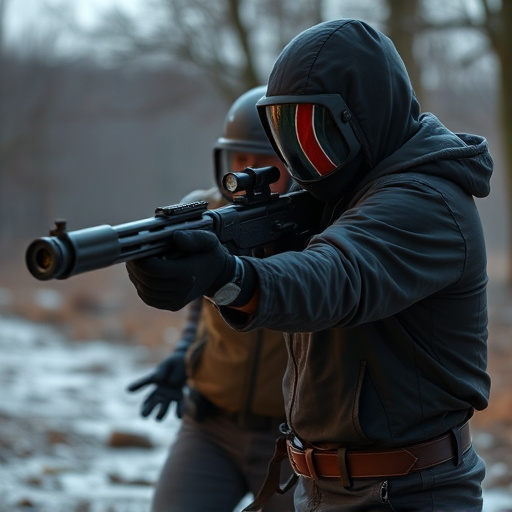Preventing Accidental Discharges: Safety Mechanisms and Educational Awareness
Accidental discharges in high-risk environments pose significant safety risks, especially regarding…….
Accidental discharges in high-risk environments pose significant safety risks, especially regarding long-term neurological stun effects. Caused by improper handling, equipment malfunction, or environmental conditions, these incidents can lead to cognitive and sensory impairments. To mitigate these risks, stringent safety protocols, regular equipment maintenance, and comprehensive training programs are crucial. Modern firearm manufacturers incorporate advanced safety mechanisms like smart technology and sensor-based activation to minimize accidental discharges. Secure storage, trigger locks, and biometric access controls at home, along with responsible handling training, reduce long-term neurological stun effects. Educational initiatives focusing on accident causes, risk mitigation strategies, and psychological aspects foster a culture of safety, significantly decreasing the likelihood of accidents in industrial, military, and domestic settings.
Accidental discharge of firearms is a critical public safety concern, leading to severe injuries and fatalities. This article delves into understanding the root causes and risks associated with such incidents, focusing on the role of design safety mechanisms in modern weaponry. Furthermore, it explores emerging evidence linking accidental discharges to long-term neurological stun effects, highlighting the need for comprehensive prevention strategies at home and educational initiatives to mitigate these dangers.
- Understanding Accidental Discharge: Causes and Risks
- The Role of Safety Mechanisms in Firearm Design
- Long-Term Neurological Impacts: A Growing Concern
- Implementing Effective Prevention Strategies at Home
- Educational Initiatives: A Key to Reduced Accidents
Understanding Accidental Discharge: Causes and Risks

Accidental discharge, particularly in high-risk environments like industrial and military settings, poses significant safety concerns. Understanding the causes and potential risks is paramount in developing effective prevention mechanisms. One of the critical aspects to consider is the impact on human health, especially focusing on long-term neurological stun effects. These accidents can result from various factors such as improper handling, equipment malfunction, or environmental conditions. For instance, exposure to hazardous materials or high-pressure systems can lead to severe consequences if a discharge occurs unexpectedly.
The dangers extend beyond immediate physical injuries. Long-term neurological stun effects are a growing area of concern, with research indicating potential cognitive and sensory impairments. By recognizing these risks, we can implement stringent safety protocols, regular equipment maintenance, and comprehensive training programs to minimize accidental discharges, thereby ensuring the well-being of workers and the surrounding environment.
The Role of Safety Mechanisms in Firearm Design

The design and development of firearms go beyond aesthetic appeal and functionality; modern firearm manufacturers prioritize safety mechanisms to prevent accidental discharges, ensuring responsible ownership and use. These safety features play a pivotal role in mitigating potential risks, especially regarding long-term neurological stun effects. Accidental firings can lead to severe injuries or fatalities, making the implementation of robust security protocols indispensable.
One of the primary safety mechanisms focuses on trigger design, employing specialized springs, sensors, and locking systems to prevent inadvertent triggers. Additionally, many modern firearms incorporate smart technology, such as electronic safety switches and sensor-based activation, which require intentional user input to fire, significantly reducing accidental discharge risks. These innovations not only enhance safety but also contribute to a more responsible and controlled ownership experience, ensuring that guns are handled with the utmost care to prevent potential harm, including long-term neurological stun effects.
Long-Term Neurological Impacts: A Growing Concern

Accidental discharge, especially in firearms and other weapons, can have severe consequences, with long-term neurological impacts emerging as a growing concern among experts. Research indicates that even seemingly minor incidents can lead to permanent brain damage, cognitive impairments, and behavioral changes due to secondary effects such as shock, trauma, and prolonged exposure to high-intensity noise. These effects are particularly pronounced in children and young adults whose brains are still developing.
The long-term neurological stun effects can manifest in various ways, from reduced attention span and memory issues to motor skill deficits and even emotional disorders. As the number of accidental discharges increases, so does the need for robust prevention mechanisms that go beyond basic safety training. Enhancing awareness about these hidden dangers is crucial, as many victims may not immediately recognize the severity of their injuries, leading to delayed treatment and exacerbated outcomes.
Implementing Effective Prevention Strategies at Home

Implementing effective accidental discharge prevention mechanisms at home is crucial, especially considering the potential for long-term neurological stun effects. Simple yet robust safety measures can significantly reduce risks associated with firearms and other weapons. One of the primary strategies involves secure storage options such as locked safes or cabinets designed to keep weapons out of reach of children and curious minds. Additionally, installing trigger locks and using biometrics or code access for firearms adds an extra layer of protection.
Regular training and education on responsible weapon handling are also vital components. Teaching all household members about the proper use and care of firearms can prevent accidents and ensure everyone understands the risks involved. Moreover, keeping a clean and organized environment, with weapons stored separately from ammunition, reduces the likelihood of accidental discharges. These measures not only promote safety but also foster a culture of responsible weapon ownership.
Educational Initiatives: A Key to Reduced Accidents

Educational initiatives play a pivotal role in preventing accidental discharges, especially considering the potential long-term neurological stun effects associated with such incidents. By incorporating comprehensive training programs into safety protocols, individuals can gain a deeper understanding of the risks and responsible handling procedures. These initiatives should focus on raising awareness about the causes of accidents, including human error, equipment malfunctions, and environmental factors. Through interactive workshops, demonstrations, and hands-on simulations, participants learn to identify potential hazards and implement effective risk mitigation strategies.
Moreover, educational programs can address the psychological aspects of accidental discharge prevention. They teach individuals how to recognize and manage stress, improve decision-making skills under pressure, and foster a culture of safety within their organizations. By equipping personnel with this knowledge, companies can significantly reduce the likelihood of accidents and ensure a safer working environment, minimizing the risk of severe injuries or long-term neurological stun effects.
Accidental discharge prevention mechanisms are vital to ensuring firearm safety, reducing not only immediate risks but also long-term neurological stun effects. By understanding the causes and implementing effective strategies, such as proper training, secure storage, and educational initiatives, we can significantly minimize accidents. As we navigate the growing concerns surrounding long-term neurological impacts, it’s crucial to remember that responsible firearm ownership starts with a comprehensive understanding of safety mechanisms and their role in protecting individuals and communities.


